Toyota C-HR long-term review
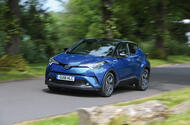 Can this Toyota hybrid put bums that don’t belong to fare-paying customers on seats? Time to find out
Can this Toyota hybrid put bums that don’t belong to fare-paying customers on seats? Time to find out
Why we’re running it: To discover whether this sharply styled crossover is Toyota’s most appealing petrol-electric hybrid yet
Month 5 - Month 4 - Month 3 - Month 2 - Month 1 - specs
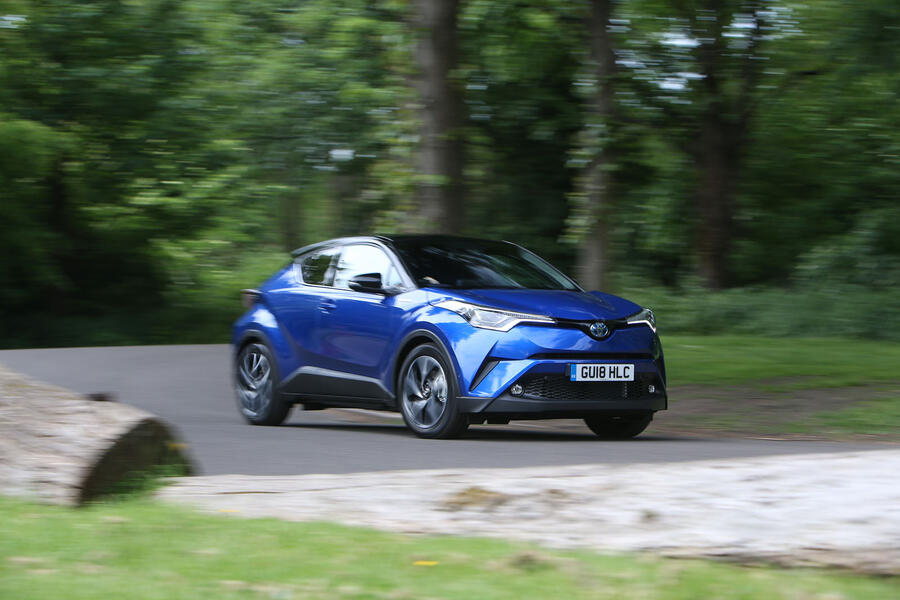
Life with a Toyota C-HR: Month 5
Plenty of space when you need it - 17th October 2018
Packing for a multi-day photo shoot, I was impressed by how the Toyota swallowed all of my kit. Folding the split rear bench is easy even with one hand, and seatbelts don’t get trapped behind the seat like on most other cars. My only real gripe is that the floor isn’t flat when the rear seats are folded, so loading heavy, bulky items can be awkward.
Mileage: 10,485
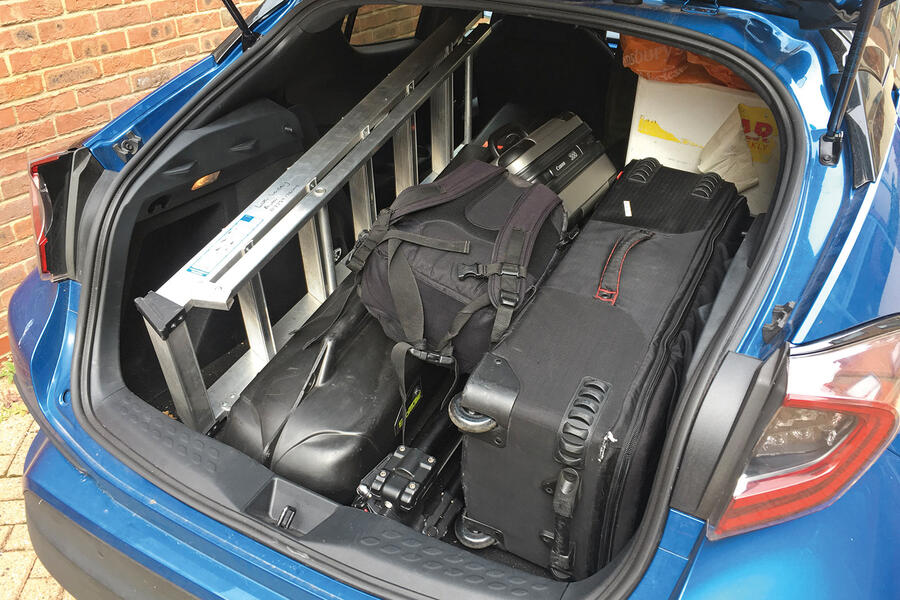
Making the most of hybrid power - 19th September 2018
I’ve grown fond of the C-HR’s hybrid drive system, especially the peace and quiet you get in stressful traffic jams. The digital energy displays highlighting when battery power is being used/generated makes driving efficiently more engaging and enjoyable. Commuting in and out of Britain’s bustling capital city in silence has been a joy.
Mileage: 9456
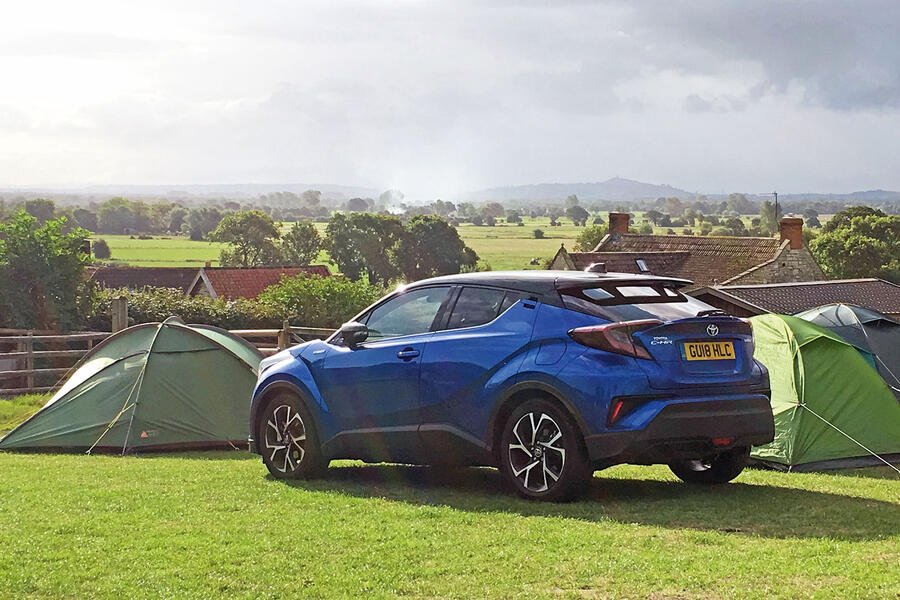
More shopping or rear passengers? Maybe you can have both - 5th September 2018
It has been a fortnight of many miles and several times I’ve had cause to head to the West Country. It turns out you can learn a lot about a car when you’re stuck in a jam on the A303 at Stonehenge during holiday season and the traffic seems to be moving more slowly than the standing stones.
Firstly, I’d say an electrified vehicle is the least stressful car to have under you in a traffic jam. You can just glide forward gently and silently on battery power, and the rapid response from the electric motor is useful when you have to claim a gap in the traffic as your own. As those around you simmer (you can hear them vividly when the C-HR’s combustion engine isn’t engaged) you start to appreciate other details of the car that perhaps you might have hitherto taken for granted.
For instance, the cupholders are brilliant in this car. Even the road testers thought as much when they ran the ruler over the C-HR back in January, and those chaps can be quick-tempered when their grande mocha frappuccinos can’t be securely stowed. They’re wide and have clever false bottoms beyond which lies extra depth. (The cupholders that is, not the road testers.)
I’m not overly sold on the siting of the USB point, which is partially hidden when I’m looking down from the perspective of the driver’s seat, and I find it particularly difficult to fumble around for at night. Also, my iPhone 6 Plus doesn’t quite sit flat on the shelf provided for such items unless I remove its protective case.
Our Toyota is also now being put to regular use as a pack horse for photographer Luc Lacey, who has cause to exploit rather more of the available stowage space than me and my coffee cup. The C-HR has 377 litres of room for luggage in the back, rising to a maximum of 1160 litres if you fold down both elements of the 40/60 split rear bench, load your gear to the roof and eject your rear passengers. Luc rarely travels light whether he’s working or adventuring, but the Toyota is proving adequate for his needs, provided he stacks carefully.

During one of my journeys back from the West Country, an object was spat up by the tyre of another vehicle and hit the lower centre of the windscreen, leaving two very small divots.
From the outside, they look like hardly anything at all – I tried and failed to photograph them clearly to illustrate this article, so you’ll have to look really hard – but viewed from the driver’s seat, I can distinguish two small cracks radiating out from one of the pits.
I’m a born worrier, so I took the C-HR to the local branch of Halfords, which is just down the road and does windscreen chip repairs. “They’ve done a nice job on the interior” was the assessment of the Halfords chap when he sat in the driver’s seat to see the windscreen damage from my perspective.
He dismissed the divots as inconsequential. Then, after we’d both been a bit distracted by his well-used Mitsubishi FTO 2.0 V6 in the car park, he said the damage to the C-HR’s screen was so slight that he wouldn’t even be able to pump in any of the resin they use to repair cracks.
In an age where many sales staff are all too quick to try to upsell you a load of gubbins that you didn’t come for and don’t really need, it was a pleasant surprise to find one who was honest and a Japanese car buff, too.
Love it:
BI-TONE ROOF I’ve seen quite a few C-HRs without the contrasting roof and they don’t look nearly as good.
Loathe it:
SAT-NAV MAPPING I yearn for more detail of minor roads on the sat-nav map to make spontaneous shortcuts possible.
Mileage: 7769
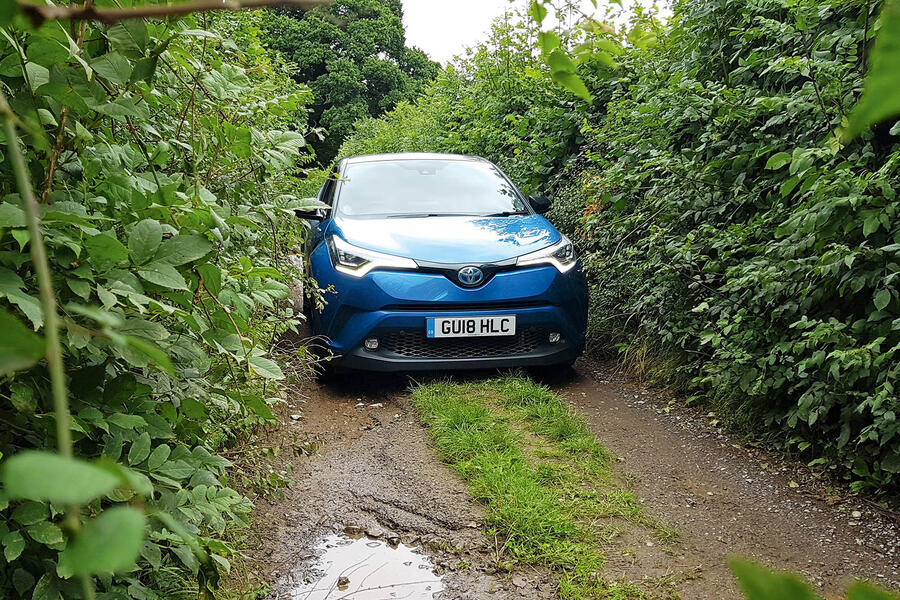
Life with a Toyota C-HR: Month 4
Hidden handles work well with C-HR's looks - 15th August 2018
I recall a car designer once telling me that ‘hidden’ rear door handles on five-door hatches weren’t great because prospective buyers could easily mistake the car for a less practical three-door and strike it off their wish lists. Mind you, Toyota has done a decent job of making an interesting design feature out of the rear handles on the C-HR.
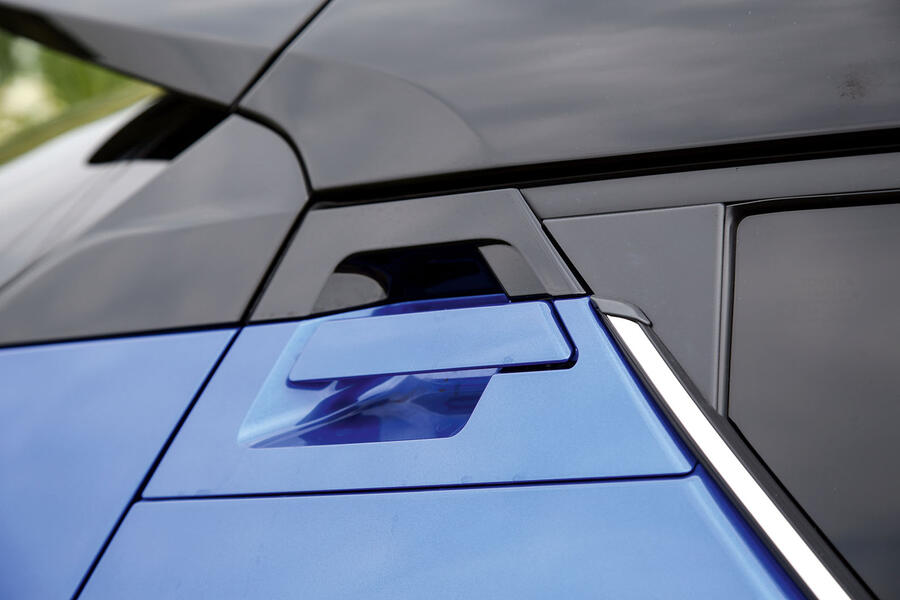
Mileage: 6089
Life with a Toyota C-HR: Month 3
Improving your fuel economy isn’t easy on an empty stomach - 23rd July 2018
I thought I’d try to get an accurate handle on the C-HR’s fuel economy. You know what? I think it has left me even more confused than before as regards whether our hybrid Toyota is great or merely good at fuel sipping. Either that or my grade C in maths GCSE isn’t worth the paper it is written on.
I tried measuring consumption over a couple of brim-to-brim fuel runs but they returned quite different figures of 47.3mpg and 52.9mpg, despite both tanks of unleaded being expended over a similar mix of M3 motorway and urban roads. Perhaps it isn’t too surprising that a vehicle that is continually switching between two power sources can return such varied results.
The likelihood is that on some of the trips conducted during my tests, I would have been crawling along in heavy traffic on the M3 and using the electric motor more frequently, whereas on others I’d be zipping along at motorway speeds exclusively using the 1.8-litre petrol.
The possibility of very varied fuel economy was emphasised when I made an impulsive dash to the local takeaway very late one evening. On the outward 1.2-mile journey, the C-HR recorded 73.2mpg; on the return, just 56.9. No surprise that a) there’s a long downhill on the way to China Garden and b) I was famished and wanted to get home quickly.
What’s clear is that traffic conditions, road topography and driving style all contribute to getting the best out of the C-HR hybrid. Additionally, there’s still a degree of guesswork involved in the calculations, because it’s very difficult to gauge precisely how much fuel is left in the tank. I’ve usually been pumping in 33-36 litres. The C-HR hybrid has a 43-litre capacity, so when I see the low fuel warning light, there’s a reserve of about seven or eight litres. Which seems like quite a lot.
Incidentally, the 1.2-litre petrol C-HR has a 50-litre fuel tank because it doesn’t need to make space for the hybrid system. As I’ve mentioned in previous reports, I think it is possible to overthink the deployment of the hybrid system. The beauty of the parallel hybrid is that you can just let it do its own thing.
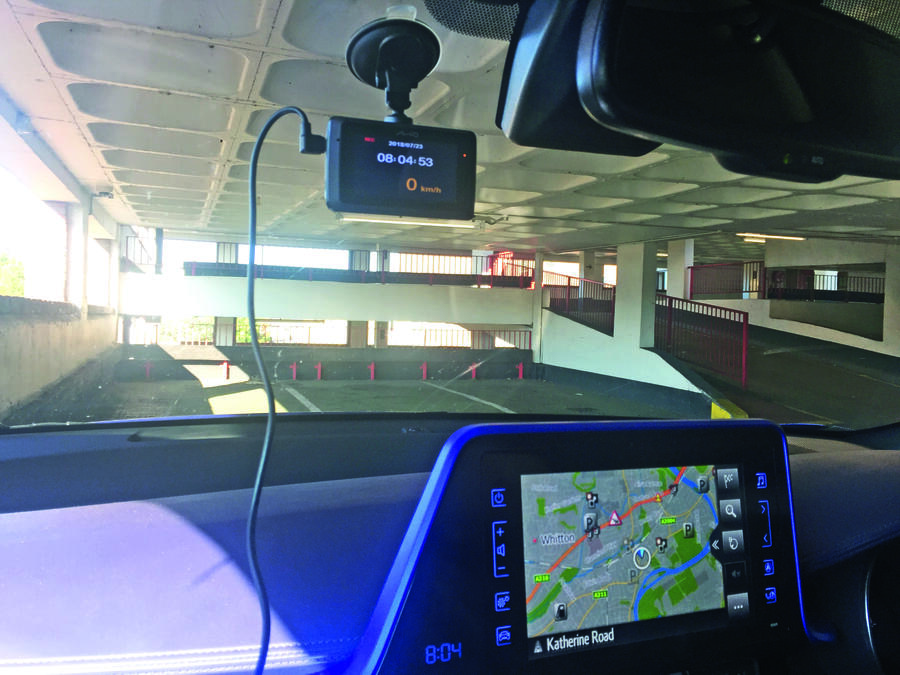
Since my last update, we’ve equipped our C-HR with a dashcam. Not too long ago, the numberplate of a car in my possession was cloned and I had to go through a tedious process of proving I wasn’t in the place where the cloned car was at a certain time and date. At the time, a dashcam would have provided clear evidence that I was in fact where I claimed to be.
The unit we have is a Mio MiVue 788 Connect, which retails for £179.99. It records in HD and has wi-fi and Bluetooth, so you can download recordings to your smartphone via an app. It also has GPS monitoring, which logs your location and speed. Installing it was a simple two minute job and it’s a compact unit with a 2.7in touchscreen. It draws power from the 12V charging point and begins recording automatically when you start the ignition.
In the C-HR, the 12V point is in the deep cubby between the front seats, so the dangling wire is less than ideal, but crucially it’s really easy to remove both the camera and the bracket from the windscreen – something I prefer to do whenever I’m parking in public areas.
Love it:
EV MODE LOCK Being able to lock the C-HR in electric mode for short spells at slow speeds is useful for parking and last-mile manoeuvres.
Loathe it:
GLOSS BLACK DETAILING A day at the beach involving children, ice cream and sand highlighted how easily some of the cabin materials get grubby.
Mileage: 4906
Life with a Toyota C-HR: Month 2
Interior trim suits the Toyota's exterior swagger, but... - 11th July 2018
I admire the unusual purple-ish textured material inside the front door. The inside of the door itself is intricately styled, which is nice, although it does mean a rather awkwardly shaped cubby. It is as narrow as a Mars bar at one end but wide enough for a water bottle at the other. On second thoughts, perhaps that is perfect…
Mileage: 4023
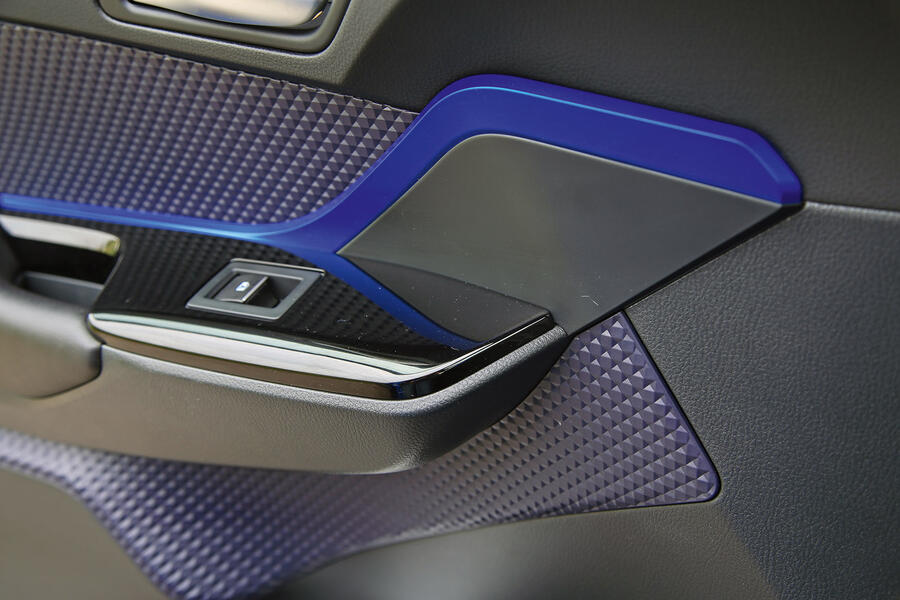
How to channel your inner Jackie Stewart without getting egg on your face - 4th July 2018
Now that the high-riding hybrid hatchback has been with us for more than a month, we’ve been able to subject it to some more of the ‘real world’ tests that your average family car would have to cope with.
As you’ll note from the test data below, the average fuel economy has taken a slight knock now that I’m pelting up and down the M3 on my commute five days a week. On those journeys, I’m relying more heavily on the petrol engine.
Obviously that’s the power source that the C-HR decides it needs to call upon for 70mph driving, but I’m at least partly to blame – being the person making the control inputs. I had hoped my driving would be sufficiently conscientious to tease the fuel economy up into the mid-60mpg region. I clearly need to become a scholar of Sir Jackie Stewart and his theory of driving more smoothly by imagining you have an egg betwixt the sole of your right shoe and the throttle pedal.
On the other hand, there’s an argument that parallel hybrids such as the C-HR are at their most effective when you don’t overthink and just let it do its thing. This is especially true on those short journeys of the kind that you might undertake at a weekend when you’re doing chores – trips to the tip, the garden centre or the supermarket, for example. On around-town trips of a few miles, I’m regarding any return less than an indicated 60mpg as a disappointment.

The aforementioned visit to the garden centre for bundles of peat and bark chippings did highlight that the C-HR’s boot has an awkwardly high load lip when you’re carrying cumbersome items. True, it’s not quite as difficult as the Atlas stones test in the World’s Strongest Man competition, but if a manufacturer is positioning its car as an SUV, as Toyota is with the C-HR, it needs to be fully adept at the ‘utility’ part of that equation.
In a similar vein, since the five-door C-HR first arrived I’ve been sceptical about its generosity of space for rear passengers, but that’s proven to be a deception of its exterior styling, which is aimed at a coupé-esque look. It’s quite busy around the rear, with the roof and bodywork tapering towards each other and the door handles integrated into the C-pillar. Our testers weren’t impressed by rear head room when the C-HR was subjected to our Road Test (4 January 2017) but I recently carried four passengers, with the three in the rear ranging from a six-foot-plus, 15-stone bloke to an infant in a carry cot, and none had reason to complain.
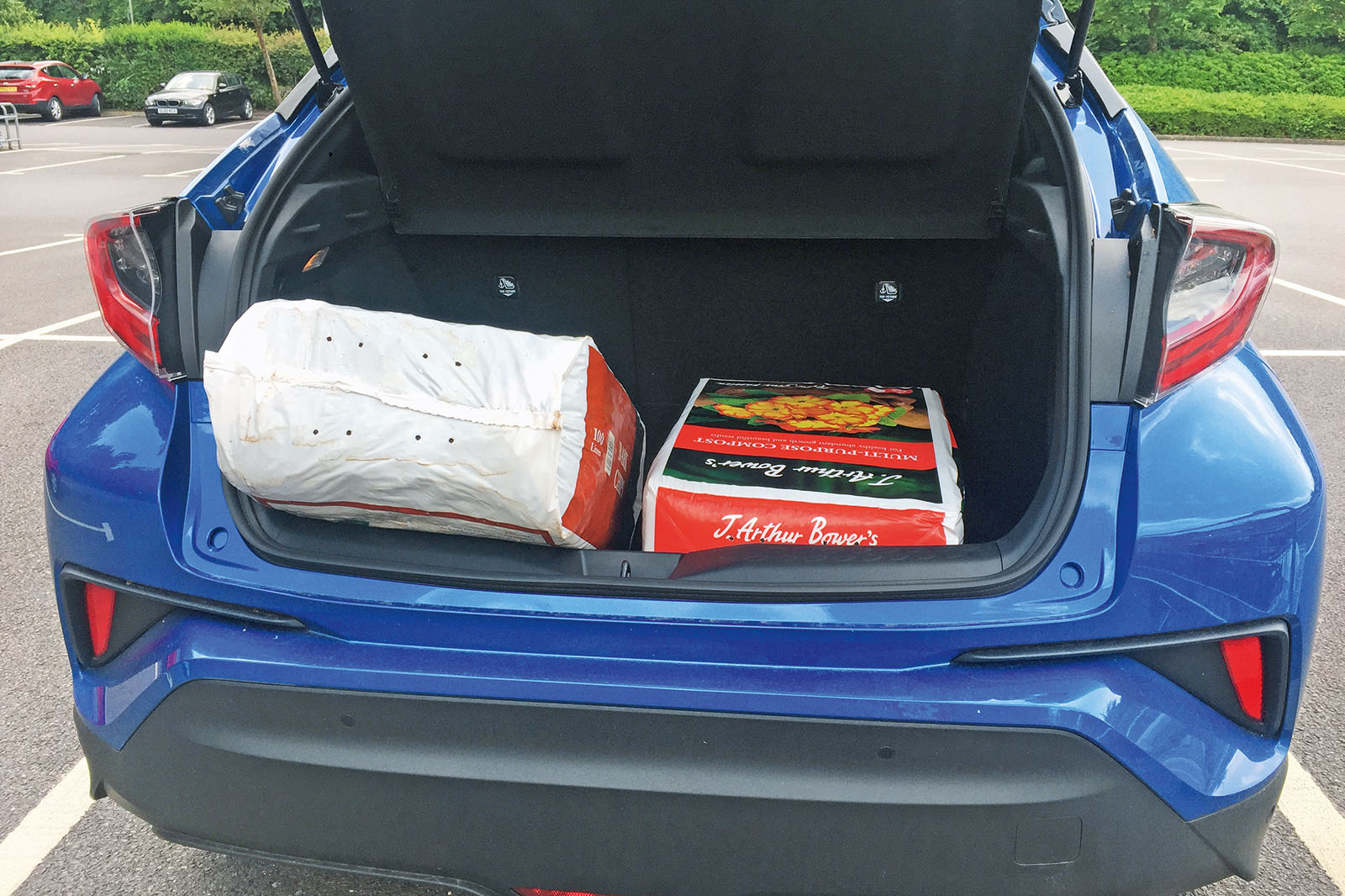
Admittedly one could only gurgle, but what those among them who could talk did note was wind noise. Perhaps this is a by-product of the car’s quiet powertrain making other external sounds more noticeable. More likely, though, is that by coming up with a shape that is appealing to a wide tranche of would-be buyers, and by jacking up the ride height, the C-HR’s ability to slice through the air as efficiently as its sibling, the super-slippery Prius, is diminished.
Wind noise or not, I’m taking a great deal of satisfaction from cruising along on electric power at any given opportunity and enhancing the C-HR’s lifetime miles per gallon figure. You might argue (with some justification) that a considerately driven Euro 6 diesel-engined car would perform just as well in terms of frugality and that might well be true for some drivers with long and traffic-free commutes.
For me, though, there are four gnarly stop-start miles at the end of my morning drive into Twickenham where the C-HR doesn’t have to rely on its internal combustion engine at all. I appreciate that won’t solve the world’s pollution ills on its own, but it does feel like a small step in the right direction.
Love it:
HOLD BUTTON Simple labour-saving device automatically applies brakes when you come to a halt. Convenient.
Loathe it:
SAT-NAV WARNINGS Traffic alert obscures the screen and doesn’t go away unless you press ‘ignore’. Distracting.
Mileage: 3422
Life with a Toyota C-HR: Month 1
Information onscreen however you want to see it - 20th June 2018
Hunting through menus that can be shown on the digital instrument panel, I discovered you can choose a g-force meter, should the mood take you. I doubt it will. Less incongruous in a fuel-sipping hybrid is the graphic that indicates whether power is coming from the engine or motor, or whether regenerative braking is sending energy to the battery.
Mileage: 2213
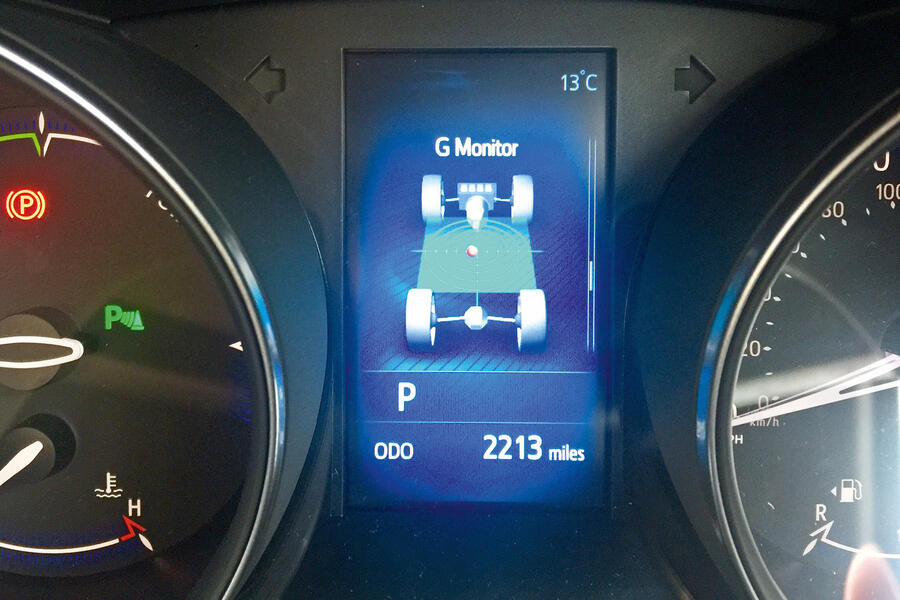
Welcoming the C-HR to the fleet — 13 June 2018
Toyota’s petrol-electric hybrid powertrains have kept it at the vanguard of electrified car technology since the advent of the Prius back in 1997, but the idiosyncratic character of that model has been both a blessing and a curse here in the UK.
Although many adopters have readily embraced the powertrain’s fuel-sipping potential, the Prius has struggled to be a car with sufficient kerb appeal for owners to want to show it off outside the school gates or the yoga class.
Sure, Matt Damon, Julia Roberts and their glamorous Hollywood chums drive them, thus bestowing on the Prius a sheen of A-list approval. But on this side of the Atlantic, a gazillion minicab drivers use it, too — and, to the best of our knowledge, ‘private-hire chic’ has yet to become A Thing among on-trend car buyers.
So the idea of wrapping the proven petrol-electric underpinnings in a boldly styled crossover body seems to be a shrewd one, because it gives Toyota a hybrid model that taps into the insatiable zeitgeisty thirst for slightly higher-riding, rugged-looking vehicles.
They say it’s what’s underneath that counts, but maybe in the case of the C-HR and Prius it really isn’t. Both are built on Toyota’s TNGA architecture and both use the manufacturer’s latest iteration of the petrol-electric hybrid powertrain, which features an Atkinson-cycle 1.8-litre petrol combined with an electric motor, driving the front wheels via an elasticky continuously variable transmission.
These aren’t the only hybrid vehicles in Toyota’s line-up in the UK; you can also get the Yaris, Auris and RAV4 in such a specification. Of them all, though, we think the C-HR looks the most dashing, especially when finished in an eye-catching metallic body colour like our test car’s Nebula Blue (a £545 option).
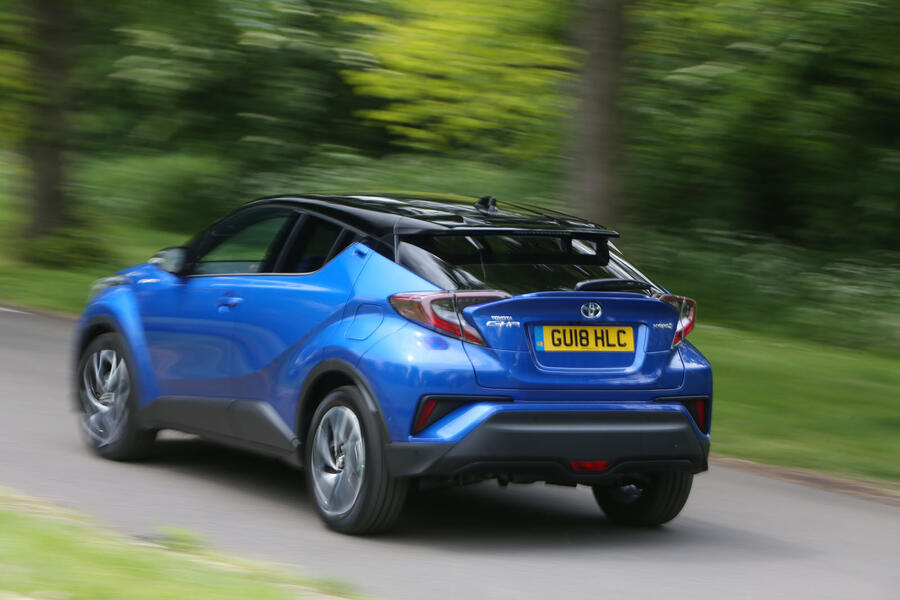
Customers seem to agree. In 2017, the first full year on sale, 10,760 examples of the C-HR hybrid were sold, establishing it as the brand’s second-best-selling petrol-electric model behind the Yaris hybrid.
We’re late to the party in welcoming a C-HR to our fleet, but we’ve not been ignorant of its appeal. When subjected to our full road test in January 2017, it elicited a solid four-star rating from our experts.
Just three variants make up the UK range, two of which are powered by a turbocharged 1.2-litre petrol. The entry-level model is front-wheel drive and has a manual gearbox, and there’s also a four-wheel-drive version with an automatic transmission. But the smart money — not to mention ours — is on the range-topping C-HR with the hybrid powertrain.
We plumped for a high-spec Dynamic model, which starts at £26,100 and comes with 17in alloy wheels, a reversing camera, automatic headlights and windscreen wipers, dual-zone air-con, Isofix points and Toyota’s Touch 2 infotainment system, which is based on an 8.0in tablet-style touchscreen integrated into the top of the centre console.
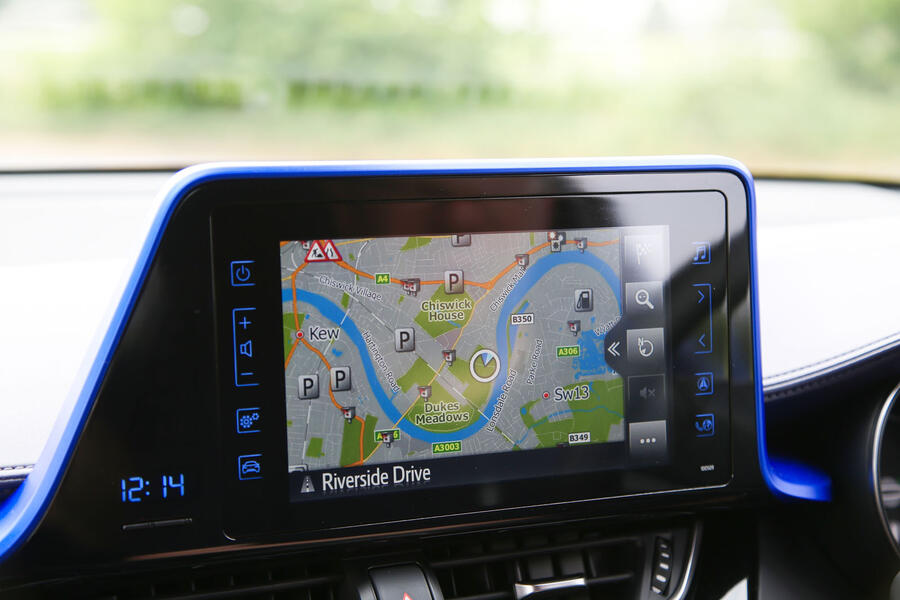
With all that kit as standard, we didn’t feel the need to add any cost options besides the aforementioned snazzy paint.
There are three key reasons why I’ve been charged with running our C-HR. First, five years ago I ran an Auris Hybrid, so I’m well placed to assess how far Toyota has moved the game on.
Second is convenience. This type of low-hassle electrified powertrain, in which the engine, battery and motor are left to do their own things, suits my lifestyle more than a pure electric or plug-in hybrid because I have nowhere to install a charging point at home.
Third, my varied daily journey will give the crossover a decent test. It will start and end in the C-HR’s urban comfort zone, where the slower speeds and start-stop traffic regularly bring the quiet and smooth electric motor into play, but in between the car has to endure the M3, where the petrol engine is called on more readily.
Can the around-town benefits of running on electric power cancel out the need to use the internal combustion engine so frequently on the motorway? I’m quite encouraged by the early signs.
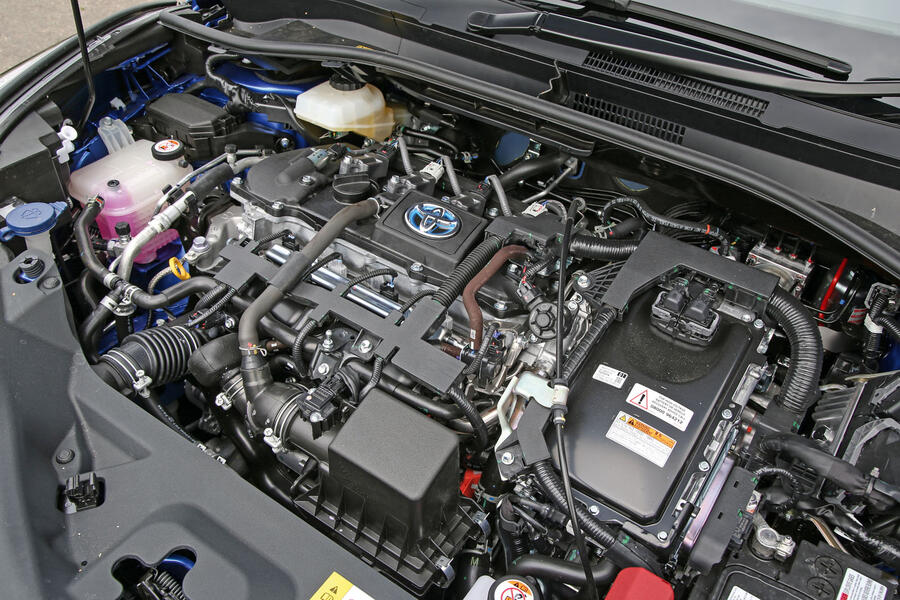
Toyota’s claimed combined fuel consumption for the hybrid C-HR is 72.4mpg and the best I’ve tickled out of it so far is an indicated 60.5mpg for my 43-mile commute home down the M3. However, I’m confident that even better figures will be possible when I’m fully in tune with the driving style required to get the best out of the hybrid powertrain.
A dramatic improvement over the Auris that I’ve already come to appreciate is the interior, which is a welcome change over the dour sea of black that greeted me in the hatchback. Full marks to Toyota for lifting the ambience with some bold colour inserts and some downright funky textures and flourishes. I’ll pick out some of the highlights in future updates.
I’m also pleased with how nice the C-HR is to amble about in. It rides and handles rather well, with an entirely appropriate emphasis on comfort rather than any kind of misplaced sporting pretensions, and it doesn’t feel compromised by any weight penalty conferred by the electric motor and battery pack.
A big thumbs-up so far, then, not least because nobody has yet mistaken me for a minicab.
Second opinion
A car of contrasts. Edgily aggressive in exterior design (I’m less sold on the interior), yet its hybrid powertrain best suits a relaxed, calm driving style. Exercise discipline in not mashing the accelerator too often and you’re rewarded with a pleasant drive and decent fuel economy.
James Attwood
Toyota C-HR Dynamic Hybrid 1.8 CVT specification
Price New £28,695; Price as tested: £29,160; Options: Metallic paint (£545)
Engine 4 cyls, 1798cc, petrol, plus electric motor; Power 120bhp; Torque 105lb ft; Top speed 106mph; 0-62mph 11.0sec; Claimed fuel economy 72.4mpg; Test fuel economy 56.7mpg; CO2 87g/km; Faults None; Expenses None
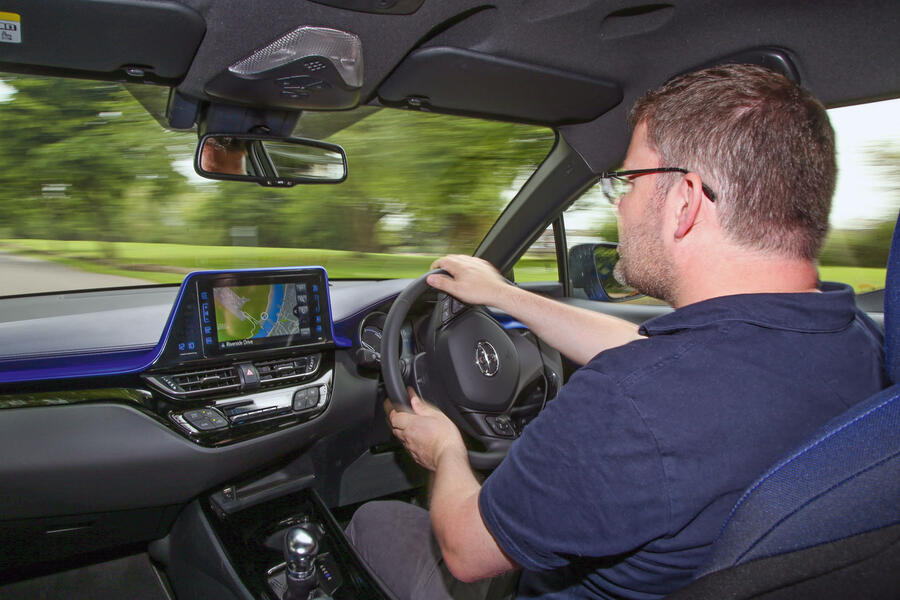
Comments
Post a Comment